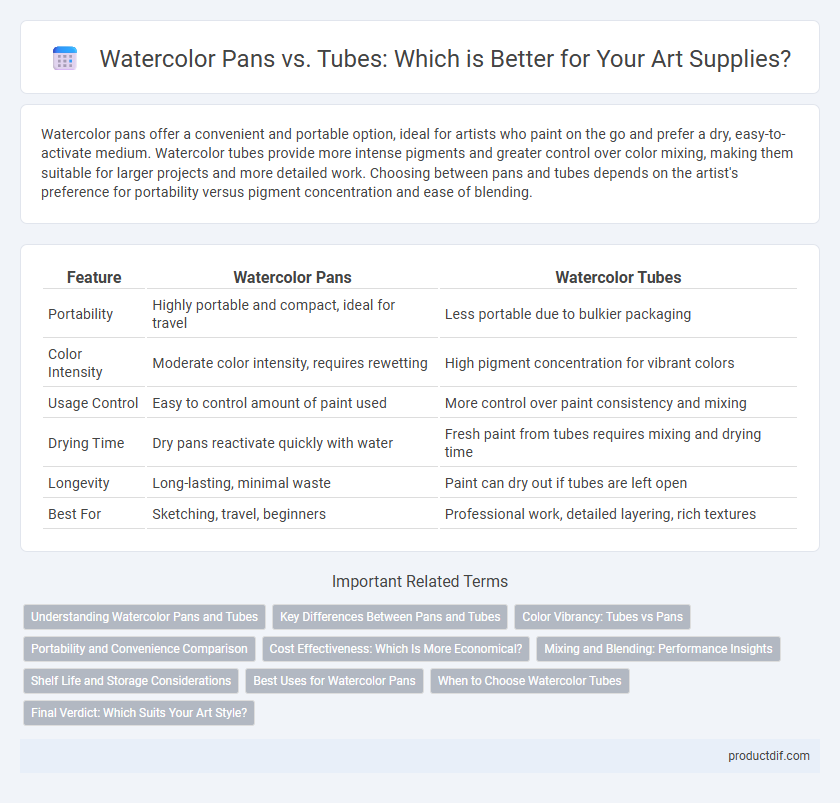Watercolor pans offer a convenient and portable option, ideal for artists who paint on the go and prefer a dry, easy-to-activate medium. Watercolor tubes provide more intense pigments and greater control over color mixing, making them suitable for larger projects and more detailed work. Choosing between pans and tubes depends on the artist's preference for portability versus pigment concentration and ease of blending.
Table of Comparison
| Feature | Watercolor Pans | Watercolor Tubes |
|---|---|---|
| Portability | Highly portable and compact, ideal for travel | Less portable due to bulkier packaging |
| Color Intensity | Moderate color intensity, requires rewetting | High pigment concentration for vibrant colors |
| Usage Control | Easy to control amount of paint used | More control over paint consistency and mixing |
| Drying Time | Dry pans reactivate quickly with water | Fresh paint from tubes requires mixing and drying time |
| Longevity | Long-lasting, minimal waste | Paint can dry out if tubes are left open |
| Best For | Sketching, travel, beginners | Professional work, detailed layering, rich textures |
Understanding Watercolor Pans and Tubes
Watercolor pans offer concentrated pigment in a dry, compact form ideal for portability and controlled water mixing, while watercolor tubes provide vibrant, saturated colors ready for immediate use with varying pigment intensity. Pans excel in minimalistic setups and travel-friendly palettes, whereas tubes allow greater flexibility in mixing and layering due to their higher pigment concentration and moisture content. Artists often choose pans for ease of use and convenience, while tubes are preferred for rich texture and color depth in detailed or expansive watercolor artwork.
Key Differences Between Pans and Tubes
Watercolor pans contain dried, compressed paint that activates with water, offering convenience and portability ideal for travel and quick sketches. Watercolor tubes provide fresh, vibrant pigments with greater control over consistency and mixing, preferred for detailed, large-scale works. Pans are space-efficient and less messy, while tubes allow easier customization of paint saturation and layering techniques.
Color Vibrancy: Tubes vs Pans
Watercolor tubes generally offer more intense and vibrant colors compared to pans due to their higher pigment concentration and moisture content. Tubes allow artists to control the amount of pigment and water, resulting in richer, more saturated hues. Pans provide convenience and portability but tend to produce softer, more translucent washes that may lack the bold vibrancy found in tube watercolors.
Portability and Convenience Comparison
Watercolor pans offer exceptional portability due to their compact, self-contained design, making them ideal for artists who paint outdoors or travel frequently. In contrast, watercolor tubes provide more paint volume and flexibility but require extra containers and mixing palettes, reducing convenience on the go. Choosing between pans and tubes depends on whether ease of transport or paint variety takes precedence in an artist's workflow.
Cost Effectiveness: Which Is More Economical?
Watercolor pans offer a more cost-effective solution for beginners and casual artists due to their compact size and longer-lasting pigments, making them ideal for travel and on-the-go painting. Watercolor tubes provide greater pigment intensity and versatility, but the paint is consumed faster, often leading to higher ongoing expenses. Evaluating typical price per milliliter and usage frequency reveals pans as the economical choice for budget-conscious artists seeking longevity and portability.
Mixing and Blending: Performance Insights
Watercolor pans offer convenience and controlled pigment release, making them ideal for precise mixing and subtle gradient blending, especially in small-scale works. Watercolor tubes provide richer, more concentrated colors that blend effortlessly on the palette, enabling dynamic layering and vibrant transitions ideal for larger or more expressive paintings. The choice between pans and tubes directly impacts color intensity and mixing flexibility, influencing the overall performance in watercolor techniques.
Shelf Life and Storage Considerations
Watercolor pans offer longer shelf life due to their dried, solid form, which resists drying out and remains usable for years if stored in a cool, dry place. Watercolor tubes, containing moist paint, have shorter shelf life and require airtight sealing to prevent oxidation and drying, often lasting only one to two years after opening. Proper storage for pans includes avoiding direct sunlight and humidity, while tubes benefit from refrigeration if not used frequently to extend their usability.
Best Uses for Watercolor Pans
Watercolor pans are ideal for artists who prioritize portability and convenience, making them perfect for outdoor painting and travel. They offer controlled pigment amount, which helps beginners manage color mixing and reduces waste. Additionally, pans dry quickly, allowing for easy reactivation with water, suited for detailed and layered techniques.
When to Choose Watercolor Tubes
Watercolor tubes provide intense, vibrant pigment concentration ideal for artists needing rich color saturation or large-scale projects. They offer greater versatility by allowing easy mixing of custom shades and adjusting pigment intensity through dilution. Choose watercolor tubes when working on detailed layering, expansive washes, or when portability is less critical than color control and variety.
Final Verdict: Which Suits Your Art Style?
Watercolor pans offer portability and convenience, making them ideal for artists who paint outdoors or prefer a compact palette, while watercolor tubes provide richer pigment intensity and greater control over color mixing, suited for detailed or larger-scale works. Artists seeking vibrant, blendable washes and precise layering often favor tubes, whereas beginners or casual painters may benefit from the ease and cleanliness of pans. Ultimately, choosing between watercolor pans and tubes depends on your artistic style, painting environment, and desired pigment strength.
Watercolor pans vs Watercolor tubes Infographic

 productdif.com
productdif.com